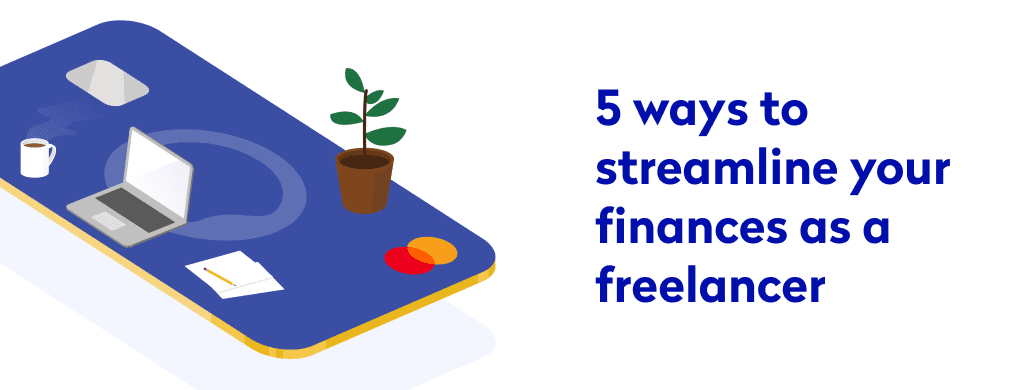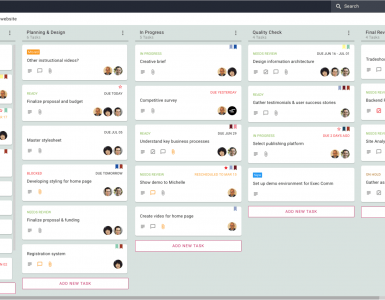
Despite managing a dozen things when running your self-employed business, knowing how to streamline your finances should be your first step.
From finding new clients to making sure your existing ones are happy; there’s a lot to consider when growing your freelance empire. Thinking about your finances and accounting can feel like a chore when you’re hungry to achieve your goals. It’s okay looking for exciting new projects – but do you know how to streamline your finances?
In this article, we’ll prove to you that bookkeeping and finance managing doesn’t have to be a grind. You’ll learn how to get your accounting systems in place, as well as methods of getting paid on time. We’ll even show you how to raise your rates to achieve your income goals faster.
Let’s dive in.
1. Get your accounting in order

The first step in creating an organized financial system is getting the foundations right. This includes finding an accountant, a bookkeeper, and choosing the right accounting software.
You may be asking; what’s the difference between an accountant and a bookkeeper? Well, they both serve different purposes. However, both are invaluable as your business grows. Here’s a quick breakdown:
- Accountants help you make sense of the numbers in your business. They provide the big picture, using your financial analytics and other data, to make strategic decisions
- Bookkeepers take care of the day-to-day financial tasks in your business. These include making sure your transactions are accurately recorded
Many freelancers enlist the help of an accountant from the very beginning. By doing this, you’ll avoid any potential tax issues as you grow your business, and it will ensure you’re in line with HMRC’s rules.
The more clients you take on, the more complex your financial records may become. An accountant will help you make sense of this financial data, while a bookkeeper will ensure your transactions are properly organized. Knowing this can allow you to streamline your finances in a way that is beneficial and long-lasting.
2. How to get invoices paid on time

There’s nothing worse than delivering a great piece of work, only to be ghosted when sending and chasing invoices. Sometimes, even if you streamline your finances correctly, it’s actually your client that is the cause of your downfall. Luckily, there are processes you can put in place to get paid on time.
The first step is to prevent any problems in the first place. You can do this by setting expectations at the beginning of your client relationships, outlining how you send invoices and what your payment terms are (e.g. NET 30 for 30 days after receipt of invoice).
You can also accept credit cards, making it easier for clients to pay you. Integrate your payment processor of choice (such as Stripe or GoCardless) with your accounting software. Send invoices that allow clients to click a button and enter their card details.
Additionally, you can deter late payment by charging a late fee. For example, some contractors include a late payment clause in their agreement where a percentage of interest is charged against late payments. This is possible thanks to the Late Payment of Commercial Debts (Interest) Act 1998, and you can learn more about how much you’re entitled to here.
However, even when you’ve put in the groundwork to get paid on time, you may still find yourself chasing unresponsive clients.
On the rare occasion this does happen, follow this process:
- Don’t panic. Sometimes, things just fall through the cracks. Send a gentle reminder via email, asking if your client received your invoice in the first place
- Make sure you’re reaching out to the right person. If there’s an accounts payable department, ask your client if it’s more appropriate to reach out to them directly
- If email doesn’t work, consider calling them by phone to ask if they’ve received your previous correspondence
When on the phone, ask your client if there are any issues that you can address. Find out when they can make the payment, and feel free to provide some flexible payment options if they have any issues beyond their control.
If you still struggle to get paid, then you may need to seek legal action. This can be done through mediation, statutory demand, or court action. You can learn more about these options in this guide.
3. Should you operate as a sole trader or limited company?

This is one of the most common questions – both for seasoned freelancers and beginners. Registering as a sole trader and limited company both have their pros and cons. When you’re learning how to streamline your finances, this can be a tricky decision to make.
When you’re just starting out, it’s common to register as a sole trader – especially if this is a side project while you work a full-time job. However, it’s advised that you eventually register as a limited company. Here’s why:
- A separate legal entity usually means a separate bank account. This makes managing personal and business transactions much easier
- Having separate accounts also means it’s far easier to remain compliant with HMRC rules
- The amount of tax you must pay as a sole trader will be much higher when earning more than £25,000, compared to the amount of corporation tax for the same amount of turnover
- Responsibilities and liabilities fall upon the limited company, not you as an individual. If you happen to run up debt, you’re not personally liable for it and your personal assets will be protected
In short: it’s wise to register as a limited company if you have ambitious goals for your freelance business. This will save accounting and tax issues while helping you build a business asset in the long term.
4. Choosing the right business account

When setting up a limited company, you’ll need a separate bank account to go with it. There are lots of options out there, so you need to make sure you select the right business current account for your needs. You should consider opening a separate business account when you start processing many transactions, or if managing your business and personal transactions becomes complicated.
For sole traders, this will depend on how fast you grow and the complexity of your business model. If you’d like to start accepting credit card payments from clients, it’s wise to open a separate business account first. When you streamline your finances in the long run, this will be much easier.
Many high street providers will charge you a transaction fee alongside set monthly fees. Other providers, such as Tide, will only charge you a bank transfer fee, ATM cash withdrawal, and cash deposit. As a freelancer, make sure you find an account that caters to your level of income.
Here are a few questions to ask yourself when evaluating a business current account provider:
- How easy is it to open an account? Do you need to wait for approval, or can you open and access an account online in minutes?
- Must you go in-branch for an interview and sign reams of paperwork?
- How attractive are their offers, and how long do they last? Some providers will offer you deals in your first year of doing business with them. After that, you may end up paying higher rates than other providers.
To open a business current account with Tide, you’ll need a document to prove your identity (such as your driver’s license) and a document to prove your address (such as a council tax or utility bill). You’ll also need your Companies House registration number, as well as details on turnover, company directors, etc.
If you would like to learn more about quickly opening a business’s current account, check out this guide for advice on making the right decision.
5. Charging profitable freelance rates

Having the right accounting and financial dashboard systems in place puts you in a great position to streamline your finances efficiently. But this is only useful if you’re running a profitable freelance business in the first place.
Setting higher freelance rates is one of the quickest wins you can achieve to build a profitable business. But many freelancers are often averse to raising their rates, or even charging what they believe they’re worth.
Let’s look at the simple economics around charging higher fees. Let’s say your rate is £250 for your services, and you have a revenue goal of £5,000 a month. In order to achieve this revenue goal, you’d need to acquire 20 clients (assuming you have the capacity for it).
Now let’s say you double your rate to £500 per project. Now all you need is 10 clients to hit your revenue goal. And while some clients may be turned off by those rates, you can take a hit on the conversion rate as you’ll need fewer clients to reach your goal.
Raising your prices in this way requires a mindset shift. Don’t look at what you do as a commodity. The value in your service isn’t just the services or projects you deliver.
Look at your value as the result or outcome you deliver to your clients. For example, if you’re a web designer, don’t see yourself as someone who builds great-looking websites. Instead, position yourself as someone who creates business websites that attracts new customers and generate sales.
By focusing on the outcome of your service, not the service itself, you will position yourself to charge the rates you deserve.
Ready to get hired? At Twine, we have dozens of top-quality jobs being posted each and every day. From design to marketing, development to copywriting – there’s a job ready for your skills. Join the marketplace of diverse creative talent here.








